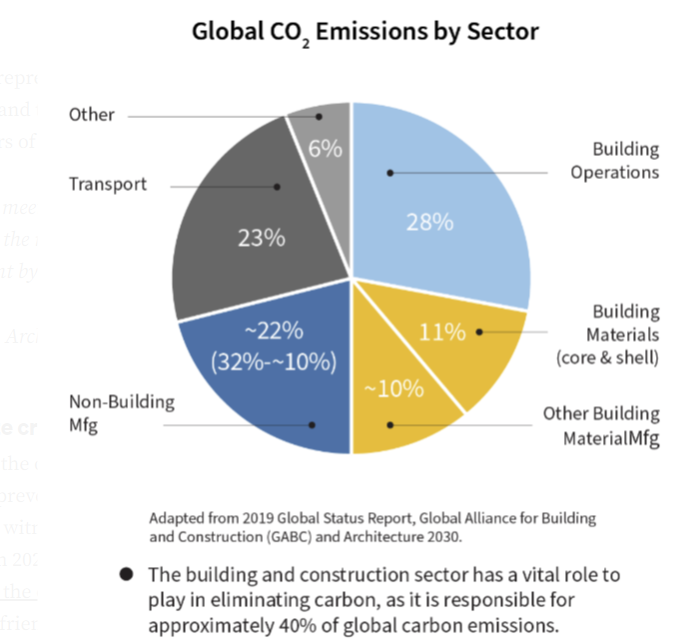Why should sustainability be at the forefront in the AEC Industry


· 4 min read
I thought of making my second post in this series about the reason we see sustainability as an emerging area of focus in the built environment and why it should be in focus for all the right reasons. In my ongoing research on this topic, I have come across some excellent articles, seminars, and reports that I will try to synthesize here for someone who has limited time and wants to get the Cliff Notes version.
Before we really start, I want to bring into perspective the importance of focusing on the built environment to be more sustainable.

These numbers represent the massive scale of the impact and hence the opportunity at hand to implement strategies and innovate to influence one of the largest sectors of the economy.
If the world is to meet the 1.5°C carbon budget set in the 2015 Paris Agreement, we must provide the necessary leadership and reduce CO2 emissions in the entire built environment by 50–65% by 2030 and reach zero carbon by 2040.
Edward Mazria, Architecture 2030
Underlying this, the core reason why I think we are at an inflection point in taking action to prevent a full-scale climate disaster. I can’t think of anyone I know that hasn’t witnessed at least a few catastrophic climate events in the past few years. In 2020 during the peak isolation days of the COVID pandemic, I saw pictures of the orange smoke filled skies of San Francisco coming in from my closest friends while staring at the glass window of my 500 sq ft apartment with a now obscured view of the Space Needle which was also because of smoke filled skies traveling from fires along the west coast. I remember having a breakdown more than once. I had just moved to Seattle few months ago and I couldn’t believe this is the reality we now face and the places and people I love are all going through this. I was in India this summer (2022) when India saw one of the highest recorded temperatures to date. The hurricanes, flooding, and heat waves all just seem to be too frequent, too potent, and closer to us each time. I know that millions of people are experiencing far worse and catastrophic consequences already across the world.
I think it is imperative that AEC industry takes this as a calling and integrate sustainability into the core strategies of their workstreams and optimize processes to achieve significant carbon reductions and/or net zero goals and also focus on regeneration & resilience in the built environment.
This might be an oversimplification but the essence of the argument I believe is true. More people are aware of the impact of the places they live in, work or use have on the environment and care deeply (despite the politics and media narratives). A good majority of buyers and renters would go for a greener building that potentially enables utility cost savings and a better quality of life, provided it’s affordable. We have some work to do on that front & stop always generalizing “green” is equal to “expensive”.
Studies have also shown that employees prefer to work in green buildings — a building that is designed better for having open green spaces and daylighting that is known to boost productivity. It is simply a more fun and productive environment to work in, not to mention the fact that large proportion of younger generations entering the workforce want their employers to demonstrably do better in ensuring a better future for all. It’s a talent hiring and retention strategy. It certainly was one of the factors that influenced my decision to join my current company as a fresh out of grad school student who studied sustainability. There was an unquantifiable value in walking into a Net Zero office building in Phoenix, Arizona for my onsite interview and feeling a sense of awe towards this living lab concept that I had only read about. It simply is good business to build sustainably.
Next week, I am planning to write a post on the positive trends that I see in this direction that are influencing the next era in sustainable building. Happy reading!
Future Thought Leaders is a democratic space presenting the thoughts and opinions of rising Sustainability & Energy writers, their opinions do not necessarily represent those of illuminem.
illuminem briefings

Adaptation · Environmental Sustainability
Sareh Moosavi

Effects · Adaptation
Beatriz Sousa

Energy · Energy Management & Efficiency
Mashable

Carbon Removal · Green Tech
CNN

Climate Change · Building Materials
Canary Media

Energy · Energy Sources